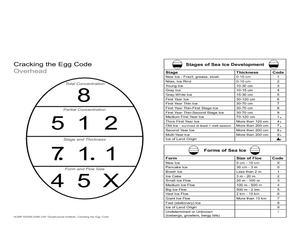Student Handouts
Break the Code: Earth Science
Crack the crust of earth science vocabulary with this vocabulary exercise. Kids use the key at the top of the page to decode the words that are written in numbers rather than letters. Each encoded word is part of a sentence that includes...
Curated OER
Crack the Code
Pupils solve a cryptogram puzzle to determine facts about fossil fuels. They "crack the code" and describe their method of solving the puzzle to their classmates.
Curated OER
Cracking the Code
Students explore encoding systems and decoding technology. In this barcoding lesson students examine how coding impacts society including distribution, and inventory.
Curated OER
Cracking the Code - Cloning Paper Plasmid
Young scholars explore the "genetic code." They observe how genes may be manipulated for genetic research, gene cloning, and genetic engineering. In a lab setting, students examine the mechanics involved in cutting and ligating DNAs...
Curated OER
Cracking the Genetic Code
Students investigate different purposes for manipulating DNA. After reviewing the structure and functions of DNA, students explore topics related to the use or manipulation of DNA and the potential benefits and problems, later making a...
Curated OER
Cracking the Genetic Code
Learners examine an article, "Genome 'Treasure Trove'" and participate in a class discussion prior to researching further information in order to write their own feature article on the Human Genome Project.
Curated OER
Sea Ice: Unscrambling the Egg Code
Students determine sea ice thickness, concentration, and floe size by reading egg codes. In this sea ice conditions lesson, students color code a map based on prescribed criteria and use the maps to identify changes in sea ice...
Curated OER
Cracking the Code of Life
Students examine the concept of DNA. They work together to extract DNA cells from their classmate's cheek. They answer questions related to what to do with their DNA now that they have it.
Curated OER
Secret Codes
Students examine Morse code and how it is used. In this secret codes lesson students decode messages, make their own codes and have other students crack the code.
Curated OER
Sea Ice: Cracking the Egg Code
Students study the egg code to learn about sea ice. In this sea ice lesson plan, students discuss and view a diagram to learn about the egg code when describing sea ice and its thickness. Students work in groups to play a game using the...
Discovery Education
Blueprint for Life
DNA is the code for all biological traits, both plant and animal. Using an exploratory lesson, learners begin to explore the concept of a biological code by decoding word puzzles. They then extract DNA from plant cells using detergent to...
Curated OER
Implications of the Human Genome Project
Young scholars study the Human Genome Project through classroom discussion and the video, Cracking the Code of Life. They research reports about the issues of disease, human health, and the ethical, legal, and societal implications of...
Curated OER
Cracking the Genetic Code
High schoolers explain what the knowledge of DNA can tell us about ourselves and other organisms and species. They also explore the systematic study of the human genome.
Curated OER
Name That Tune: Matching Musical Tones Through Waveform Analysis
Pupils detect the waveform of musical notes to determine the code for the "safe" in this forensics simulation lesson. They use a microphone and tuning forks along with Vernier EasyData on their graphing calculator to analyze five musical...
Kenan Fellows
Unit 4: Bioethics and the Future of Biotechnology
What's the future of biotechnology? Explore a hot topic in the fourth and final unit in a series of Biotechnology lessons. Learners develop an understanding of the many issues in bioethics, then create an argument for or against the role...
Curated OER
Invertebrates
For this science worksheet, learners answer the problems that are related to the concept of invertebrates. The first question has the ordering of and sorting of invertebrates.
Curated OER
Chromosomes And DNA
In this science worksheet, students complete 2 sentences about chromosomes and DNA. Students also list the 4 bases that have "special names."
Curated OER
Disproving the Proof
Students investigate the progression of discoveries that have led to the genetics knowledge that scientists currently have. They determine how genetic experiments disproved previous theories on inheritance.
Curated OER
Should Humans Be Cloned?
Learners explore links on the Internet to collect facts about cloning then prepare an essay on their findings. In this research writing lesson students examine how to include their opinions on what they have found in their research.
Curated OER
Gene to Protein
Mutation and auxotrophs are discussed. Next, the details of RNA transcription and how enzymes can control splicing and introns are given.
Curated OER
Fish, Amphibians, Frogs
In this science worksheet, students use basic scientific concepts to complete the series of puzzles that are intended to increase science literacy for telling the differences between fish and amphibians.
Curated OER
Building a Model DNA
Students explain the function of DNA in the body. In this biology lesson, students build a DNA model using simple materials. They demonstrate how bases pair up in the helix.























